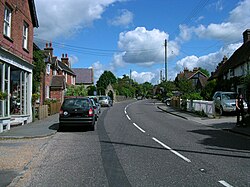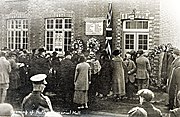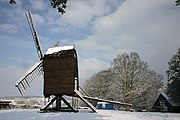Nutley, Sussex
| Nutley | |
| Sussex | |
|---|---|
 Nutley village | |
| Location | |
| Grid reference: | TQ442279 |
| Location: | 51°1’57"N, -0°3’18"E |
| Data | |
| Post town: | Uckfield |
| Postcode: | TN22 |
| Dialling code: | 01825 |
| Local Government | |
| Council: | Wealden |
| Parliamentary constituency: |
Wealden |
Nutley is a village in Sussex, in the Rape of Pevensey about five miles north-west of Uckfield, the main road being the A22. Nutley, Fairwarp and Maresfield together form the Maresfield civil parish.
The village is on the southern edge of Ashdown Forest which was a deer hunting reserve from the time of King Edward II. Iron has also played an important role in the history of the area.
History
The Romans operated nearby in Duddleswell and Maresfield, working the iron ore to be found in the local Weald Clay using bloomeries. Roman coins and waste from furnaces has been found at these locations.
Little remains here of the Anglo-Saxon period except for the village's name, meaning "Nut meadow".
In 1176 a chapel was built by Richer de Aquila ('L'Aigle'). It was thought to have been built in an area known as Chapelwood, along the Chelwood Gate road, just outside Nutley to the north-west. Sixty acres of land near Wych Cross on Ashdown Forest were granted to the chapel. The chapel was attached to the church at Maresfield, and went out of use after the Reformation.
A field survey by Nutley Historical Society [1]found no evidence of the chapel in that area but John Kelton's 1747 map of Ashdown Forest shows the ruins of the chapel located south of Nutley Inn on the east side of the main road. Hearsay evidence of a local historian suggested 'odd stones' were found during the building of Nutley Hall which stands roughly where Kelton's map sites the ruins of the chapel.
In 1372 King Edward III gave the Chapel of Notlye (as it was called at the time) along with almost 1,400 acres of land to his son, John of Gaunt. They were both frequent visitors to Ashdown Forest (then known as Lancaster Great Park; it would keep that name for the next three centuries) because of the hunting.
Contraband goods, shipped across the English Channel, were smuggled along the packhorse track from Duddleswell to Nutley. In 1721 Gabriel Tomkins, the leader of the Mayfield Gang, was captured and arrested in Nutley having been chased from Burwash. Tomkins was sentenced to seven years transportation, but gained his freedom by giving valuable information to the authorities. He went on to have a mixed career as both smuggler and customs officer, being Custom House Officer at Dartford in Kent in 1735 and Bailiff to the Sheriff of Sussex, but was hanged in 1750 at Bedford for robbing the Chester stage coach.[2]
Nutley Windmill, a rare example of an open trestle post mill, was moved to Nutley from Goudhurst, Kent around 1817, her timbers being older than this. Standing on the edge of the forest she was modernised in the 1880s and operated until 1908.
It was only in the mid-19th century that the village school and the church, St James the Less, were built. The land upon which the school was built was donated by the Earl and Countess De La Warr. Both the school and church are still in use today.
Piped water was first introduced to the village in the early 20th century, but electricity and telephones did not arrive until the 1930s.
During the First World War and Second World War, Canadian troops were stationed at Pippingford Park near Nutley. During the Second World War a Wellington bomber returning from a raid over Germany crashed nearby in the Ashdown Forest, in a location now known as Airmans Grave and the crew were all killed. In 1944 a stick of bombs from a German aeroplane fell in Nutley, resulting in minor damage. A Spitfire flown by a Polish pilot caught fire and crashed[3] on Funnels Farm down Nether Lane, killing the pilot and a BF109e piloted by Hans Bertram [4] crashed in Nettlefold FIeld, killing him.
Society
In 1921 a local businessman, Albert Turner donated a large brick granary and oasthouse for conversion into a village hall and war memorial, across the road from Whitewood's store and Post Office. A second memorial hall was built in the 1970s, replacing the original hall which was converted into a residence.
The new hall stands opposite the school, and encompasses the social club, set of meeting rooms, a hall with stage, caretakers residence and the Parish Council office. The land upon which this second memorial hall stands was donated by the Nettlefold family. Today it is managed by the Nutley War Memorial Charitable Incorporated Organisation [5]
Pictures
| ("Wikimedia Commons" has material about Nutley, Sussex) |
-
William Figg 1858 copy of Kelton 1747 map of Ashdown Forest
-
Bow Bells milepost at Nutley in 1906 , 38 mile marker
-
Opening of the original Nutley Memorial Hall in 1924
-
A group of Canadian soldiers stationed at Pippingford Park near Nutley in 1941
-
Nutley Windmill
Outside links
- Tracing the Pale of Ashdown Forest Deer Park Report: The High Weald
- Local history of Nutley: Nutley Historical Society
References
- ↑ "Nutley Historical Society". http://www.nutleyhistorical.org.uk/.
- ↑ Mary Waugh, Smuggling in Kent and Sussex 1700-1840 1985 ISBN 0-905392-48-5 pp 68-70
- ↑ "Spitfire accident report Funnels Farm". https://aviation-safety.net/wikibase/163402.
- ↑ "Kracker Luftwaffe Archive". http://www.aircrewremembered.com/KrackerDatabase/?s=400&q=,%20Heinz%20%22Hans%22&qand=&exc1=&exc2=&search_type=&search_only=.
- ↑ "Nutley War Memorial Hall". https://www.nutley-war-memorial-hall.co.uk/index.asp.





